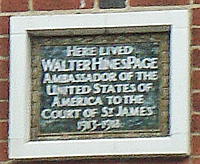Military
The Coulter Hospital opened in September 1915 in a house in Grosvenor Square lent for the purpose by Sir Walpole Greenwell (1847-1919).
Accepted by the War Office as a primary hospital affiliated to Queen Alexandra's Military Hospital at Millbank, it had 100 beds for officers. The rooms were large and lofty. One of these was an 'Australian Room' and some of the beds had been given by Australian donors. The medical staff were mostly consultants from Guy's Hospital and the Middlesex Hospital, but also included an Australian resident surgeon. The nursing staff comprised 11 nurses, 6 of whom were Australian, and 10 members of a local Voluntary Aid Detachment, whose Commandant was Lady Juliet Duff (1881-1965).
The Hospital had been founded by Mrs Charlotte Herbine, an American psychic from Indianapolis, who had raised money for it while visiting the Exposition in San Francisco. The Hospital was named after Dr Coulter, the spirit of a family physician with whom Mrs Herbine had communicated with since she was a child. Dr Coulter had directed her to go to England as he wanted to contact certain Englishmen.
One of these was the Earl of Sandwich(1839-1919), the Hospital's first President, who also contributed largely to its funds. Mrs Herbine met with the Earl at his estate at Hinchingbrooke where Dr Coulter's spirit communicated with him through the medium of Mrs Herbine or the Earl's niece, Mrs Scott-Gatty (who wrote down word for word the messages received). The Earl took up spiritual healing, following Dr Coulter's instructions on how to treat the patients.
In 1912, at the request of Dr Coulter, the 75-year-old Earl and Mrs Herbine visited India to bring certain rajahs and their people in touch with spiritual healing. At this time Dr Coulter had been much exercised about the coming European war and, in August 1914, predicted that "the carnage will be unprecedented and every country's resources taxed to the full".
At the outbreak of war Lord Sandwich had been one of the first to offer hospitality to Belgian refugees when they arrived in England and, indeed, was the Chairman of the Belgian Relief Committee. However, with the exception of patients under treatment at the Hon. Miss Cavendish's hospital in Sawtry, Huntingdonshire (now Cambridgeshire), he never practised spiritual healing during the war because of objections by the medical profession.
The Hospital closed in 1919, the year the Earl died of pneumonia, an event predicted by Dr Coulter.
Present status (August 2010)
The building was demolished in 1961 and its site is now occupied by an apartment block.

A different building now occupies the site of No. 5 Grosvenor Square.

The building bears a plaque commemorating the site of the home of the United States ambassador, Walter Hines Page, who, from 1913 to 1918, lived at No. 6 (now part of the same building as No. 5).
(Author unstated) 1917 List of the various hospitals treating military cases in the United Kingdom. London, H.M.S.O.
Erskine S (ed) 1919 Memoirs of Edward, Earl of Sandwich, 1839-1916. London, John Murray.
http://query.nytimes.com
http://trove.nla.gov.au
www.20thcenturylondon.org
www.british-history.ac.uk
Return to home page